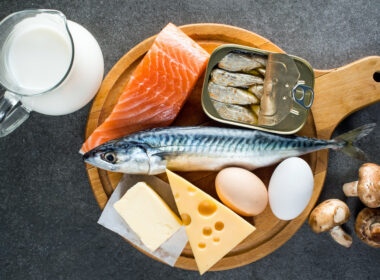Amongst other responsibilities, the U.S. Food and Drug Administration (FDA) ensures that the food Americans eat meets a “generally recognized as safe” standard, is properly labeled, and that synthetic additives receive FDA certification. However, the FDA announced in April 2025 that food companies now have two years to completely phase out a particular synthetic additive: petroleum-based dyes. Here’s what that means: If your favorite candy is colored from natural (i.e., plant or mineral sources), it’s business as usual for those companies. (While these foods still must meet FDA safety requirements, they are considered “certification exempt.”) However, for food that owes its hue to the work of an organic chemist, its days are now numbered.
The FDA didn’t ban petroleum-based dyes in the name of safeguarding reproductive health, per se. Rather, the push for phasing out these dyes seems to have more to do with études that indicate an association between synthetic food dye and adverse behavioral outcomes, such as hyperactivity, in children sensitive to synthetic dyes. And, there’s a catch: the FDA’s new requirement will only phase out six of the few dozen dyes that are permitted in foods by the FDA. However, since synthetic dye is cheap and effective, this change will affect many foods including obvious culprits like candy, colorful breakfast cereals, sodas, and sports drinks. But what you might not realize is that food dye is also used to enhance many other foods on the market. For example, dyes make canned peas more green, pickles more yellow, and everything from condiments to salad dressing, cheese, yogurt, sauces, soups, and sausage look vibrant and fresh.
There seems to be a fair bit of debate over how much of an impact these dyes have on children’s behavior. Opponents of the ban find the available research unconvincing, while some supporters declare that food dye is the singular culprit behind rising ADHD diagnosis rates among American children. However, research suggests that behavioral effects are only part of how synthetic dyes affect the body. Synthetic food dyes have been found to be endocrine disruptors, meaning that they can have far-reaching effects on health, especially reproductive health.
What is an endocrine disruptor?
Perturbateurs endocriniens are chemicals that change how hormones work in the body [1]. Usually, this is because the chemical has a similar shape and structure to the hormones or enzymes our bodies make, and can therefore disrupt the receptors that hormones usually communicate with. Endocrine disruptors can also influence how hormones are made and broken down, and they can affect neurotransmitter receptors.
We know that endocrine disruptors can get into the body through the plastique packaging that food and water are stored in, or via plastic additives like BPA. But now, *sigh,* we également need to take a good look at the food itself, or more specifically, the additives used in processed food.
Food dye and hormones
A Étude 2021 on synthetic food dyes looked at the effects of Yellow #5 and Red #3 in different concentrations on 8-week-old male rats [2]. This was a small study with five rats in each test group, and the researchers tested the rats for a period of three weeks. Rats treated with food dye at all test concentrations showed increased levels of FSH, LH, and testosterone. There was also a significant increase in the expression of a gene called interlukin1-β, which creates a pro-inflammatory protein [2].
In the short term, pro-inflammatory proteins can help the body by strengthening the immune response to fight off a pathogen. Long-term, however, an increase in pro-inflammatory proteins is associated with obesity and an increase in symptom severity for women with PCOS. Specifically, women with higher interleukin1-β levels have been shown to have higher and/or increasing insulin resistance, lower progesterone levels, and higher rates of infertility. Low interleukin-β levels help stimulate ovulation and aid embryo development [3].
Rats treated with the highest amount of food dye were found to have suffered testicular damage. This was seen in abnormal looking Leydig cells (the cells responsible for testosterone production) plus a higher ratio of immature to mature sperm cells compared to the control group [2]. It’s possible that, amongst other potential causes, decreased sperm count rates in adult human males may have something to do with eating unnaturally brightly-colored food for the past few decades.
Damage inflicted by Red Dye #3 and Yellow Dye #5
A 2024 review on food additives also looked specifically at the dyes Red #3 and Yellow #5 and their effects on the body [4]. Both dyes are derived from petroleum and have been found to act as endocrine disruptors in animal studies.
Red #3, which the FDA announced would need to be phased out of food prior to the announcement to ban additional synthetic dyes, has been associated with a number of different hormonal dysfunctions including:
- Blocking iodine uptake by the thyroid
- Decreased T3 and T4 and increased TSH
- Both mimicking and blocking effects of estrogen
- Making the immune system more sensitive [3]
Red #3 has also been shown to increase oxidative stress, a state that can lead to DNA damage and is associated with an increased risk of cancer development [4].
Yellow #5 is also thought to both block and mimic the effects of estrogen, potentially by binding to estrogen receptors. It is also thought to interfere with enzymes further up the production line in hormone synthesis, which ultimately puts limits on how much of that hormone the body can make [3].
Yellow #5 may also play a role in a process called epigenetic modification. DNA provides the instructions for all of the proteins you will ever have to make, but many of these are irrelevant to day-to-day life (since you’ve already grown all your organs). To keep things tidy, most of your DNA is neatly packaged up, restricting which genes are available for easy access. Essentially, epigenetic modification makes changes to this storage system to increase or block the expression of certain genes (and increase or block the protein they code for). The authors of the review note that since Yellow #5 is also an endocrine disruptor, this dye can both directly and indirectly affect gene expression by affecting the genes themselves or by affecting the signals that the cell uses to know when to turn on and off different genes [4].
Plant-based and dye-free foods
While the recent FDA announcement is giving food-dye some time in the spotlight, many products are already free from synthetic dyes. Organic and all-natural products will opt for plant-based coloring over artificial food coloring, and it’s now common to see products like medication and toothpaste offering dye-free selections.
The FDA recently approuvé three naturally-sourced colors as food additives. These require approval because they are specifically being used as additives and aren’t items being eaten on their own like when fruit or vegetable juice is used for color. These colors are Galdieria extract blue (from red algae), butterfly pea flower extract (also blue), and calcium phosphate (a white mineral). However, many foods from more common sources are already used as color in various foods on the shelves.
If you’re wondering what plants are being used to add a splash of color, you might be able to guess from your own experiences in the kitchen. When I make borscht, the richly pigmented beetroots stain everything hot pink for the rest of the day–from my hands to my wooden spoons. When I give my baby a carrot to gnaw on, I can expect her white shirt to quickly turn orange. And while I’ve never had the privilege of smashing grapes with my feet to make wine, I imagine the participants go home with very purple feet. The FDA broadly permits fruit and vegetable juice to be used as food color additives as well as bright-colored spices like turmeric, saffron, and paprika. For example, multicolored Goldfish list beets, huito and watermelon juice concentrate, paprika, and turmeric as ingredients used for color. Another example of a food that is prized for its color-properties is spirulina, a blue-green algae that is considered rich in nutrients and antioxidants.
Plant pigments in general offer excellent health benefits. The beta-carotene that makes carrots, sweet potatoes, and cantaloupe orange is turned into vitamin A in the body. The anthocyanins that make cherries, grapes, and pomegranates purplish-red act as antioxidants. Since these foods are used in tiny amounts for color purposes, natural food dye won’t turn colored crackers into superfoods, but it is a good reminder that eating a rainbow of foods has great nutritional benefits.
Le bilan
Food additives allow us to seemingly have it all when it comes to food in the modern world. The food we eat looks brighter, tastes better, and lasts waaay longer than it would without chemical alteration. Additives make food less expensive, more convenient, more appealing, but… they aren’t exactly nourishing. While it can be difficult to get away from processed food altogether, stepping away from synthetic food dyes is a great place to start. Not only do synthetic dyes pose a threat to our endocrine system, but they make ultra-processed treats extra tempting by hijacking our brain’s love for rich colors in food, which was the way our ancestors knew when a fruit was ripe and full of vitamins.
In short, while the FDA is giving companies two years to make the switch from synthetic dye to natural dye or dye-free food, you can get a head start today by opting for whole foods or snacks made with plant-based rather than petroleum-based dyes.







